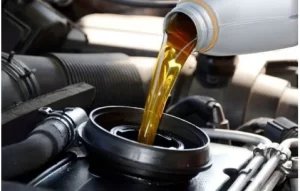
In one of our earlier articles, we covered the combustion process inside an engine. We covered the ignition section of the engine. The spark plug is a small device that provides the spark needed to ignite the combustion process. We will explore this tiny yet powerful device in this article. Its basics and functions will be explained, as well as the different types. We’ll also look at simple maintenance tips to help your car spark plug last longer.
What is Spark Plugs?
As we have already discussed, the spark plug is responsible for starting a petrol engine’s combustion process. There are three main layers to the spark plug. The threaded metal shell is the outermost layer, a threaded metallic shell that gives the spark plug its structural integrity. The side electrode is attached to the metal casing at one end. A porcelain layer is found inside the metal shell, which acts as an insulation surface for the main electrode. The main electrode is located within this porcelain shell. The porcelain casing isolates the main electrode from the side electrode.
How spark plugs work
The spark plug is connected at one end with a high-voltage source such as the magneto or ignition coil. The combustion chamber is connected to the other end of the spark plug. A potential difference between the two electrodes is created when current flows through the terminal to the main electrode. The gas mixture creates the gap between the electrodes. This is insulation, so electricity can’t flow beyond its tip.
The voltage rises, and the gas in the gap gets energized. The voltage reaches a point where it crosses the dielectric strength (resistance conductivity) of the gases. This is when they become ionized. The ionization of the gases causes them to act as conductors, allowing current to pass through the insulating gaps. The electrons will surge through the gap when the dielectric strength crosses. The sudden movement of electrons quickly increases the heat in the region, which causes them to rapidly expand, resulting in a mini-explosion that results in the formation of a spark.
Types of Spark Plugs
There are two primary classifications for spark plugs: based on operating temperatures and based upon their construction.
Based on Operating Temperatures
After the combustion cycle is complete, heat must be released. The heat is emitted through the exhaust gases and spark plug surface. Two types of spark plugs are possible depending on their operating temperature and heat dissipation.
- Hot spark plug: This hot spark plug works at a higher temperature. The ceramic area is smaller and serves to insulate heat. Hot spark plugs dissipate less combustion heat, allowing the tip and electrode to remain hotter. This makes sure that any accumulation of deposits is eliminated and doesn’t last too long.
- Hot Spark Plug: High-performance engines running hot by default will need a hot spark plug to cause pre-ignition. It can lead to tip melting in extreme cases. A cold spark plug can be used in such situations. This ceramic insulation area will dissipate heat more effectively because it has a higher value. However, this is more prone to deposit accumulation. For optimal performance, follow the instructions and use the correct plug for your engine.
Based on the Material Used
The material used at the ends of spark plugs is what further classifies them. There are four types.
- Copper/Nickel Type: These spark plugs are the most basic. The copper-nickel alloy is used as the center electrode. Copper is weak and can melt due to engine heat. To strengthen the plug, nickel is used. However, these are still the weakest available types. They also require a larger diameter, so they will need more voltage to operate.
- Single Platinum Types: These plugs feature a small, platinum-plated disc at the center electrode’s tip. This type of plug is much more durable than copper-nickel coatings. They are also less susceptible to debris buildup.
- Double Platinum Type These plugs feature platinum tips on the side and center electrodes. They ignite twice during the combustion cycle: once before and after. This spark plug cannot be used if the distributor for a waste spark ignition is installed in your vehicle.
- Iridium Type These spark plugs are the best on the market. The center electrode’s tip is made from Iridium, which is stronger than nickel, copper and platinum. They are therefore less prone to damage and deposits. A smaller-sized electrode makes them easier to operate and requires less voltage. Iridium plugs can be more expensive than other types, but you get what you pay for.
Spark Plug Maintenance and Problems:
Your car’s spark plug health will deteriorate over time. Although each manufacturer has recommendations for changing spark plugs, the ideal interval is 20,000 km. These are the most common signs that your car’s spark plugs need to be replaced:
- Once you turn on the engine, rough idle.
- Car struggles at the beginning of the morning
- Engine misfiring
- Increased fuel consumption
- Acceleration decrease
- Power surges unexpectedly
These warnings are important as improper combustion can occur when your car has a faulty ignition coil. Even though they are deteriorating, they lose their proper functioning. This can cause damage to other parts of your engine. You can extend the life expectancy of your car’s sparkplugs by performing simple maintenance. This will save you a lot of money you might otherwise spend on replacement parts due to defective spark plugs.
Here are some simple tips to boost Spark Plug life:
- Selecting the right type: You must select the correct spark plug for your vehicle before installing it. A cold spark plug will not work well for low-performance engines. It will also dissipate heat too quickly and slow down spark release. A hot spark plug could cause the tip of a high-performance engine to melt in the heat. Make sure you use the right type of plug for your vehicle’s engine.
- Clean the Electrodes: Use a special spark plug socket wrench to remove the spark plug terminal from the plug. The plug should be soaked in a thinner liquid such as diesel, petrol, or isopropyl alcohol. Use a toothbrush or sandpaper to remove any hardened deposits. You can also use a wire brush to remove the hardened deposit, but this is not recommended.
- Make sure you check the Spark Gap. It is crucial to have a spark gap between the electrodes. Sparks will not be strong if the gap is too small. It is possible to have no spark if the gap is too large. Check your owner’s manual and the internet to determine the spark gap. To measure the gap width, use a wire-coin or coin type gap measurement and adjust accordingly. It would help if you were careful when adjusting the gap between the side electrodes, as they can easily snap off.
- Clear the Mounting Area. Also, make sure to clean the area where the spark is installed. The accumulation of combustion debris in the gap can cause misalignment of the spark plug. Before mounting the spark plug, clean off any oil and debris.

















